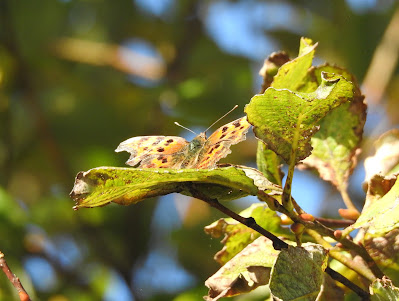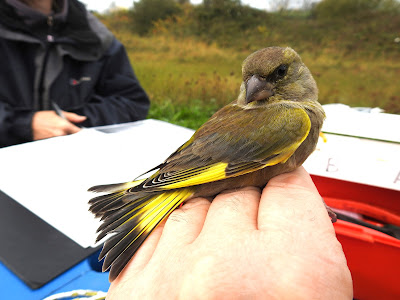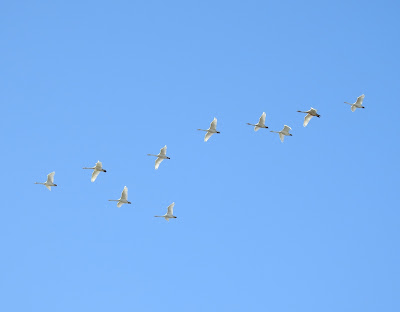This past week or so has seen the arrival of visitors from the north, both at night and during the day. Just over a week ago, Gail and I were at our wintering bird survey site south of the Ribble, and we had full cloud cover with a 15 mph south-westerly wind.
The feature of the morning was very much geese, some native and some non-native! Throughout the morning Canada Geese were constantly arriving from all directions to forage in fields surrounding our vantage point, and in total we had 1,163.
All the activity from the Canada's interested a few Pink-footed Geese, and eleven dropped in to join them, but the rest of the Pink-footed Geese that we recorded, were flying over, heading south, and we had a further 688.
On the subject of fly-overs, we did have some vis in the form of 13 Skylarks, four Tree Sparrows, five Greenfinches, 16 Meadow Pipits, a Chaffinch, a Goldfinch, and two Swallows, all moving south-ish.
I always like to mention Ravens when I see them, because they are one of my favourite birds, and this morning we had a single fly past giving its evocative croaking call. Superb! Waders were thin on the ground with just ten Lapwings, and raptors similarly so, with just two Kestrels. Collared Doves are always in good numbers here, and we recorded 32 this morning. Anecdotally, I don't seem to see anywhere near as many Collared Doves as I used to, say 20 years ago, so I must do a bit of research and see if they are indeed declining.
Over the past five days, Gail and I have had two walks along the Wyre estuary, via the Quay, and the first was exactly five days ago. It was a cool overcast morning, with a 10 - 15 mph south-easterly wind. Out on the mud within the Quay were 122 Redshanks, eleven Oystercatchers and a single Turnstone. The Turnstone was splodging around in the mud, not where I would normally expect to see a Turnstone.
The vis was light, but it was mid-morning when we were there, and we had three Skylarks, nine Meadow Pipits, a Jackdaw and 200 Pink-footed Geese, all south. Grounded migrants were limited to two Goldcrests, and fifteen Long-tailed Tits flying high to cross the Quay looked a little odd. Oh, we had a Raven as well.
We then went to have a look at an area of scrub that is northwest of the Nature Park, that Fisherman's Friends, you know the manufacturers of those disgusting lozenges, plan to extend their factory on to. Wyre Borough Council (WBC) seem recently to have been passing planning applications where ecology will very much be damaged, I suspect in a bid to work around Biodiversity Net Gain (BNG). BNG should have been introduced in November this year, and the basic premise of it is, is that any development should have at least a 10% net gain in biodiversity after the development has been completed. The shower of sh*te that we have in government in the UK at the moment, in a desperate bid to try and gain votes in next year's general election, have put back BNG until at least February next year. So, I suspect those councillors and planners at WBC that lack a moral compass, or have a conscience, are rushing all these applications through before BNG bites. Shocking, but unsurprising for a bunch of ecological hooligans like Wyre Borough Council.
The habitat that Fisherman's Friends plan to destroy in the name of greed, is a cracking area of scrub. Now, as far as BNG is concerned, this area of scrub would be classed as 'habitat mosaic', which is one of the most biodiverse habitats, on a parr with ancient semi-natural woodland for example, and as you can imagine, trying to achieve a gain of at least 10% in biodiversity after you have cleared this rich habitat mosaic, and plonked a factory on top of it would be impossible, and the development wouldn't go ahead. But low and behold, those bandits at WBC have passed it. No surprise there! I prefer to refer to Wyre Borough Council as..., well..., think of the worst swear words that you can think of beginning with W, B and C, and you'll be on the same lines as me.
From the pictures below, you can see how rich, and diverse the scrub looks, and Gail and I had planned to have a good mooch around on it. Impossible, as those manufacturers of nausea inducing lozenges, have fenced the site off with a security fence that a military installation would be proud of, and posted some goon in a high vis jacket to keep a watchful eye over the site. We did have a Cetti's Warbler (protected under Schedule 1 of the Wildlife and Countryside Act) singing from the site, and a number of Migrant Hawker dragonflies were utilising the site to hunt over. I will write to WBC and express my objections, and concerns, and point out the errors of their ways, but when the bureaucrats at Wyre Borough Council are in leagues with the devil, there probably isn't much point, bit I will.
Habitat mosaic, soon to be destroyed in the name of greed
Remember, for every foul tastng lozenge purchased, it is a contribution towards biodiversity destruction
And it isn't just biodiversity that WBC are happy to destroy for a fast buck, it is archaeology as well. Just 2 km south of the proposed Fisherman's Friends funded, and Wyre Borough Council enabled, biodiversity trashing, WBC have just passed a planning application for 158 houses on a nationally important historical site. You couldn't make it up. The site is called Bourne Hill, and recent archaeological work by Oxford Archaeology North have found evidence of occupation from the Iron Age, through to the Roman era and on to medieval times. It is classed as a Romano-British settlement.
Besides authorising the whole-scale destruction of the archaeology, those numpties at WBC are also driving rough-shod over the ecological concerns. The land adjacent to the site, and I'm talking directly north of the planned 158 houses, in fact abutting the proposed development, is an important feeding area for wintering Pink-footed Geese. In fact, it is so important, that the numbers of Pinkies using this land makes this block of land functionally linked to the Wyre Estuary SSSI, Morecambe Bay Special Area of Conservation (SAC), Special Protection Area (SPA) and RAMSAR site. In fact, Natural England (NE) have classed it as high potential functionally linked land.
What is functionally linked land I hear you ask? This is an area of land occurring outside a designated site which is considered critical to, or necessary for, the ecological or behavioural functions in a relevant season of a qualifying feature (species), for which a Special Area of Conservation (SAC), Special Protection Area (SPA) or RAMSAR (internationally important wetland) site has been designated.
What do Wyre Borough Council think of this? Well, nothing actually. There is no doubt, and I say this from 47 years' experience of bird recording, both as a birder and as a professional Ornithologist, that this development will disturb the wintering Pink-footed Geese, therefore having a negative impact on the ecological and behavioural functions of these highly designated, protected and hugely important sites for nature. And yes, you heard it right, Wyre Borough Council think absolutely nothing about that. Nationally important historical site, internationally important numbers of wintering Pink-footed Geese, just means that this land is ripe for development according to the eco-hooligans at WBC.
A local pressure group has been formed that is trying to prevent the development from happening, and their Facebook page has already generated a great deal of interest and outrage, with over two thousand followers. They are called Save Bourne Hill, and if you are a user of Facebook, I implore you to take a look and if you can, get involved and object to this horrendous proposal.
I am going to hand over to the Save Bourne Hill group for a few paragraphs, and let you hear some of their words about Bourne Hill.
Bourne Hill is unique. It was left by the Ice Age glaciers and has survived ever since; it is the only existing 'drumlin' hill on the otherwise flat Wyre peninsula, and the only one that still exists as a natural, open space …but now developers intend to destroy it forever.
Bourne Hill was home to our earliest local ancestors, thousands of years ago, when it was surrounded by water, reeds and woodland carr; an area of unsurpassed biodiversity, home to millions of birds, fish and wild animals. It was, and still is, the only natural vantage point from which we can still see all the surrounding hills and moorland, where the first people lived.
Bourne Hill has featured throughout history, from the very first account of life in Roman Britain, when Ptolemy wrote of the enigmatic port of the Setantii, the Iron age tribe who lived here. The Romans came and went, the Vikings came and stayed, the Normans took over, battles were fought, and eventually Bourne Hall stood upon the Hill, mentioned in the Domesday book and many local tales.
Archaeologists have found evidence of all this and more, including Iron Age roundhouses, early metal working, and of every period since, from the Middle Ages to WW2. Rt hon Mr Paul Maynard, MP, has applied for the site to be listed as a National Monument, due to its unique cultural significance.
Ecologists have identified the habitat of protected species on Bourne Hill and its' environs, which have been separated and sold for construction projects. Bats and birds rely on the trees, shrubs and grassland, including wintering geese and swans of international importance, as well as local nesting birds, and the land has waterways where Great Crested Newt and Water Voles are both endangered. Some of their precious habitat has already been lost, and all of it will be disturbed or totally destroyed by construction.
As thousands of local people raise their voices in opposition to the destruction, developers have rushed into construction on Bourne Hill and many other local green field sites, in a bid to beat the deadline for the law on Biodiversity Net Gain, which was due to come into force in November 2023, but has been delayed until 2024. This should force developers to pay for measures to guarantee that every construction scheme creates more biodiversity than it destroys, making such vandalism of nature virtually impossible, but already the construction companies are finding ways to evade responsibility for their actions, while greenwashing their marketing pitch with false promises of sustainable housing.
We the people who care about this land, invite everyone, everywhere, to join together with us, to save our disappearing natural world, starting right now, at home, wherever we live.
We share this country and this world. Together, we can save it.
Right, back to those visitors from the north. At the beginning of the week, I had two back-to-back ringing sessions at the Nature Park, on my own on Monday, and with Gail on Tuesday. I ringed just three birds on the Monday, but a more respectable 31 birds on the Tuesday. Below I have lumped the totals together for the 34 birds ringed:
Redwing -10
Cetti's Warbler - 1
Blue Tit - 5
Blackcap - 1
Greenfinch - 7
Long-tailed Tits - 9
Robin - 1
Going back to that Monday ringing session, I had full cloud cover, with a 10 - 15 mph westerly wind, not the best conditions for the arrival of visitors from the north. There were Redwings calling in the darkness as I put the nets up, and I recorded 22 at most during the morning. There was virtually no vis at all, and I suspect it was probably a bit murky out in both Liverpool and Morecambe Bay, so all I will mention is the two singing Cetti's Warblers singing as always.
When Gail and I arrived on site on Tuesday morning, it was misty, and I didn't hold out much hope, but as I unlocked the first gate in the darkness, to access the site, I could hear Redwings calling. We had nearly full cloud cover, and it was calm at first, but as the morning moved towards noon, a south-easterly breeze picked up. And as you know, we did ring a few Redwings, eight on this morning to be precise, and my notebook reminds me that we had 81 in total.
There was a bit more vis compared to the day before, and Jackdaws were the main feature of our vis totals. We had 110 Jackdaws, 25 Meadow Pipits, a Goldfinch, 20 Skylarks, two Swallows, a Siskin, eight Pink-footed Geese, and an Alba Wag, heading anywhere between east and west, via south.
A Sparrowhawk caused some excitement early on as it shot through the willow scrub, ducking and diving, veering left and right, in his (it was a young male) bid to flush out something for breakfast. A Golden Plover that was heard and not seen caused some excitement as well, as we don't often record them over the Nature Park.
A few Migrant Hawker dragonflies were on the wing as the day warmed, and we caught one in one our mist nets. Thankfully, they are easy to extract, and within a few seconds it was on its way. Thinking about it, that might have been the first Migrant Hawker that I have extracted, as it's usually Brown Hawkers that we catch at this site.
Yesterday, Gail and I had our second walk of the week along the Wyre Estuary and Quay, and we had more visitors from the north. Just as we were setting off on our walk, we had a flock of twelve Whooper Swans heading south, and they were calling away, with that fantastic bugling call, that very much evokes wild places. A sight and sound that our ancestors at Bourne Hill thousands of years ago would have been familiar with. And a sight and sound that WBC want to ensure that you can no longer hear on this peninsula of the Wyre.
We had a further four Whooper Swans head south, plus six Skylarks, three Magpies (high flying birds), six Meadow Pipits, a Grey Wagtail and a Red Admiral butterfly. The Red Admiral was very much migrating, it was at altitude and belting south.
The view from our usual spot The tide was running in as we sat down on our usual spot to watch the ebb and flow of the river, and the birds that it pushed ever closer. There were 191 Redshanks, 23 Turnstones, six Oystercatchers and four Little Egrets. Two of the Little Egrets walked towards each other, with the light reflecting off the water as the back drop, they paused to look at each other, when their paths crossed, and continued walking in opposite directions. I wish I had photographed the whole moment, but I hope the couple of pictures below give you an idea of the spectacle.
Silhoutted Little Egrets (above & below)
Gail missed the Kingfisher that sped low over the water of the Quay. The views weren't great as I was looking into the sun, so it was just the call, and the jizz that told me that it was a Kingfisher. Great to record nevertheless. The only grounded migrant that we had was a Chiffchaff, and as always, I must mention that we had a Raven.
The forecast is looking okay from Sunday onwards, so I have plans to go birding, ringing, surveying and setting up some trail cams on my clients' farm in Bowland. As always, I will let you know how I get on.
And if you can, have a look at what's going on with Bourne Hill, and write a letter of objection to your MP, or whoever you like, if you think it can help.



















